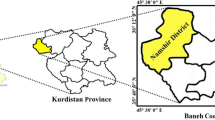Abstract
Non-timber forest products (NTFP) such as fuelwood, fodder, fruit, medicinal plants, and small timber are important to the rural poor in India. The traditional usufruct rights that the poor enjoyed have been gradually eroded by state control. This process has accelerated with increases in the prices of timber and industrial wood products. Non-timber forest products collected by the poor do not enter the system of national accounts, which results in the undervaluation of the forest wealth of the country. According to some estimates, the total demand for these products outstrips the sustainable yield of the forests in India. To ensure the best use of the forests, it is necessary for rural communities to share the responsibility of forest management with the forest departments. A proposed joint forestry project in South India is discussed as a case study of this innovative approach to forest management. Data on the existing patterns of NTFP extraction are presented to gain a better understanding of the role that these products play in the life of the rural poor. Policies from the case study are discussed in the concluding section.
Similar content being viewed by others
Literature Cited
Appasamy, Paul. 1992. Micro-watershed management: case study of a Tamil Nadu village. Pages 222–228in Anil Agarwal, ed., The price of forests. Centre for Science and Environment, New Delhi.
Arnold, J. E. 1990. Social forestry and communal management in India. Social Forestry Network Paper 11b, Overseas Development Institute, London.
Gadgil, M., and R. Guha. 1992. New forest policy for genuine friendship. The Hindu Survey of the Environment 1992. The Hindu, Madras.
Government of India. 1992. Environmental action programs—India. Interim Document. Ministry of Environment and Forests, New Delhi.
Jodha, N. S. 1986. Common property resources and rural poor in dry regions of India. Economic and Political Weekly 21:1160–1181.
Kulkarni, Sharad. 1987. Forest legislation and trib-als. Economic and Political Weekly 22:2143–2148.
Lai, J. B. 1989. Indian forests: myth and reality. Natraj Publishers, Dehra Dun, India.
Malhotra, K. C. 1992. Joint forestry in West Bengal. Paper presented at a seminar on forests for economic development and recreation. Maxmueller Bhavan, Madras.
Nadkarni, M. V., K. N. Ninan, and Syed Ajmal Pasha. 1992. Economic and financial viability of social forestry projects—a study of selected projects in Karnataka. Social Forestry Research Digest 23:40–69.
Neelakantan, K. S. 1991. Survey of fuelwood use in Tamil Nadu. Paper presented at twenty-first interdisciplinary research methodology workshop. Madras Institute of Development Studies, Hyderabad.
Palni Hills Conservation Council. 1991. Kadavak-urichi interface forestry—surveys and analysis. Ko-daikanal, Tamil Nadu, India.
Shepherd, G. 1990. Forestry, social forestry, fuel-wood and the environment: a tour of the horizon. Social Forestry Network Paper 11a, Overseas Development Institute, London.
Swedish International Development Authority. 1989. Social forestry project—Tamil Nadu phase II. Project Appraisal Document. Madras.
Author information
Authors and Affiliations
Rights and permissions
About this article
Cite this article
Appasamy, P.P. Role of non-timber forest products in a subsistence economy: The case of a joint forestry project in India. Econ Bot 47, 258–267 (1993). https://doi.org/10.1007/BF02862292
Received:
Accepted:
Issue Date:
DOI: https://doi.org/10.1007/BF02862292




